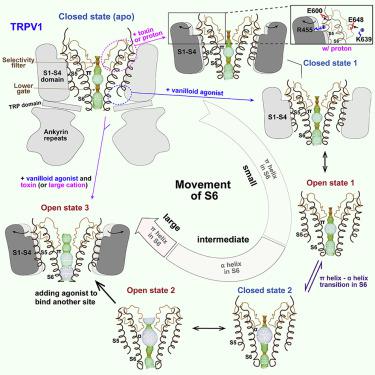Cell ( IF 64.5 ) Pub Date : 2021-09-07 , DOI: 10.1016/j.cell.2021.08.012 Kaihua Zhang 1 , David Julius 2 , Yifan Cheng 3

|
Many transient receptor potential (TRP) channels respond to diverse stimuli and conditionally conduct small and large cations. Such functional plasticity is presumably enabled by a uniquely dynamic ion selectivity filter that is regulated by physiological agents. What is currently missing is a “photo series” of intermediate structural states that directly address this hypothesis and reveal specific mechanisms behind such dynamic channel regulation. Here, we exploit cryoelectron microscopy (cryo-EM) to visualize conformational transitions of the capsaicin receptor, TRPV1, as a model to understand how dynamic transitions of the selectivity filter in response to algogenic agents, including protons, vanilloid agonists, and peptide toxins, permit permeation by small and large organic cations. These structures also reveal mechanisms governing ligand binding substates, as well as allosteric coupling between key sites that are proximal to the selectivity filter and cytoplasmic gate. These insights suggest a general framework for understanding how TRP channels function as polymodal signal integrators.
中文翻译:

TRPV1的结构快照揭示了多峰功能的机制
许多瞬时受体电位 (TRP) 通道响应不同的刺激并有条件地传导大小阳离子。这种功能可塑性可能是由一种独特的动态离子选择性过滤器实现的,该过滤器由生理剂调节。目前缺少的是直接解决这一假设并揭示这种动态通道调节背后的具体机制的中间结构状态的“照片系列”。在这里,我们利用低温电子显微镜 (cryo-EM) 可视化辣椒素受体 TRPV1 的构象转变,作为模型来了解选择性过滤器如何响应致痛剂(包括质子、类香草激动剂和肽毒素)的动态转变,允许大小有机阳离子渗透。这些结构还揭示了控制配体结合亚状态的机制,以及靠近选择性过滤器和细胞质门的关键位点之间的变构耦合。这些见解提出了一个通用框架,用于理解 TRP 通道如何作为多模态信号积分器发挥作用。



























 京公网安备 11010802027423号
京公网安备 11010802027423号